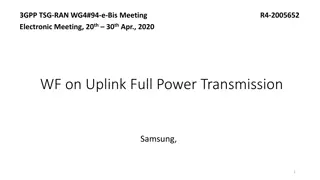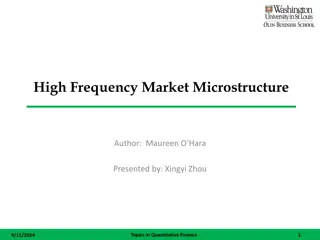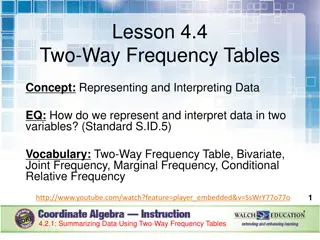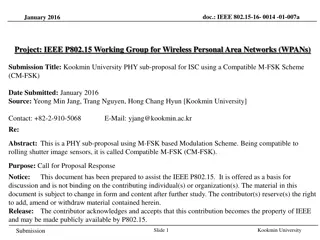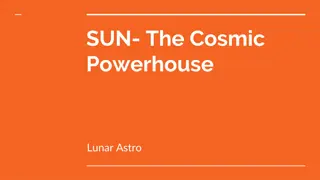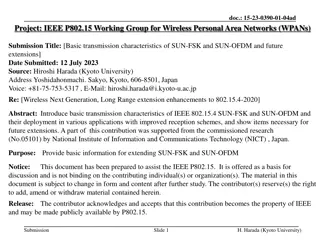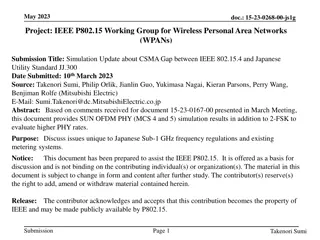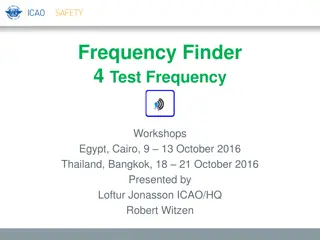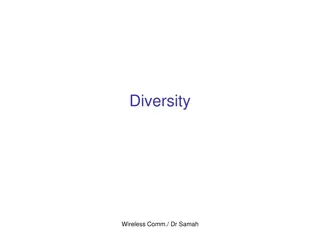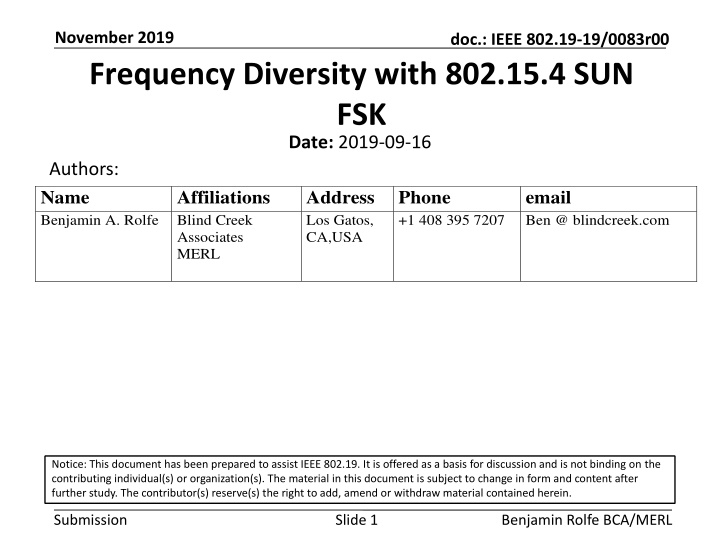
Insight into Frequency Diversity with 802.15.4 SUN FSK
Explore the benefits of frequency diversity as a coexistence and reliability-enhancing mechanism in 802.15.4 SUN FSK technology. Learn about frequency hopping, channel diversity, and the impact of various channels on system performance and reliability.
Download Presentation

Please find below an Image/Link to download the presentation.
The content on the website is provided AS IS for your information and personal use only. It may not be sold, licensed, or shared on other websites without obtaining consent from the author. If you encounter any issues during the download, it is possible that the publisher has removed the file from their server.
You are allowed to download the files provided on this website for personal or commercial use, subject to the condition that they are used lawfully. All files are the property of their respective owners.
The content on the website is provided AS IS for your information and personal use only. It may not be sold, licensed, or shared on other websites without obtaining consent from the author.
E N D
Presentation Transcript
November 2019 Frequency Diversity with 802.15.4 SUN FSK Date: 2019-09-16 Authors: Name Affiliations Address Benjamin A. Rolfe Associates MERL doc.: IEEE 802.19-19/0083r00 Phone +1 408 395 7207 email Ben @ blindcreek.com Blind Creek Los Gatos, CA,USA Notice: This document has been prepared to assist IEEE 802.19. It is offered as a basis for discussion and is not binding on the contributing individual(s) or organization(s). The material in this document is subject to change in form and content after further study. The contributor(s) reserve(s) the right to add, amend or withdraw material contained herein. Submission Slide 1 Benjamin Rolfe BCA/MERL
November 2019 doc.: IEEE 802.19-19/0083r00 Frequency Diversity Channel Diversity Duty Cycle = 10.000000% 1.0 0.8 channels = 129 probability of success 0.6 channels = 64 0.4 0.2 channels = 1 0.0 0 100 200 300 400 500 number of nodes Submission Slide 2 Benjamin Rolfe BCA/MERL
November 2019 doc.: IEEE 802.19-19/0083r00 Diversity is A good thing As a coexistence mechanism As a reliability enhancing mechanism Popular Commonly used with 802.15.4 SUN FSK (15.4g) PHYs and other PHYs Various kinds but we will talk (mostly) about spreading information across multiple well defined frequency channels in some time varying pattern (aka hopping). Submission Slide 3 Benjamin Rolfe BCA/MERL
November 2019 doc.: IEEE 802.19-19/0083r00 Frequency Hopping Overview Popular with 802.15.4 SUN FSK use Primary goal is to improve reliability o Mitigate interference impacts o Adapt to environment Tradeoffs between reliability and latency o Can add significant latency depending on implementation choices o Popular in low data volume applications More channels == more benefits o SUN FSK relatively narrow channels o More popular where there are more channels o enough channels can be a few MHz Submission Slide 4 Benjamin Rolfe BCA/MERL
November 2019 doc.: IEEE 802.19-19/0083r00 Impact of a few channels Channel Diversity 1% duty cycle 500 competing nodes o Single channel o 10 channels o 16 channels (50kbps) Duty Cycle = 1.000% 1.0 0.8 channels = 16 channels = 10 probability of success 0.6 0.4 More is better but a few is still better than one (a lot better) 0.2 channels = 1 0.0 0 100 200 300 400 500 number of nodes Submission Slide 5 Benjamin Rolfe BCA/MERL
November 2019 doc.: IEEE 802.19-19/0083r00 With typical SUN FSK channelization 802.15.4 SUN FSK 902-928MHz band 1% duty cycle 500 competing nodes o Single channel o 64 channels (150,200, kbps) o 129 channels (50kbps) Submission Slide 6 Benjamin Rolfe BCA/MERL
November 2019 doc.: IEEE 802.19-19/0083r00 Channel (slow) Hopping Some characteristics of popular schemes: Relatively long loiter time (dwell) on channel o Full packet or multiple packet transfers per dwell Fixed dwell duration o If transmission cannot complete by end of dwell interval, wait for next dwell interval o Predictable timing Dynamic dwell duration o Nominal dwell interval set o Dwell may extend to complete packet and/or packet-ack exchange Many ways to determine channel sequence o Some degree of randomness essential (more generally better) Submission Slide 7 Benjamin Rolfe BCA/MERL
November 2019 doc.: IEEE 802.19-19/0083r00 Fast Hopping Short loiter time (dwell) on channel o Fragment of a packet transferred per dwell o Full packet spread over multiple channels o May combine with coding and spreading (e.g. 15.4w) Fixed Fragment size and dwell duration o A fixed number of bits sent per burst on a channel o Predictable timing Dynamic fragment size and dwell duration o Adapted based on channel condition estimates o Change fragment size and dwell varying by channel, over time, etc. Many ways to determine channel sequence o Some degree of randomness essential (more generally better) Submission Slide 8 Benjamin Rolfe BCA/MERL
November 2019 doc.: IEEE 802.19-19/0083r00 Typical Features Pseudo random channel sequences Unique sequences per participating device Designed to achieve balanced distribution across usable channels May have limits on maximum duty cycle per channel o US FCC 15.247 400ms per within a 20 second period per channel; o EU duty cycle % capped based on band, power allowed Ability to avoid bad channels (blacklisting) o Measurement of channel condition e.g. packet failure rates, channel access failure rates, channel sounding Submission Slide 9 Benjamin Rolfe BCA/MERL
November 2019 doc.: IEEE 802.19-19/0083r00 Control Listener directed (listening schedule) o Each device has a listening schedule which channel it will receive on at a given time o To transmit, sender learns listening schedule of destination o Determines channel at time of desired transmission Transmitter directed o Transmitter has a schedule of which channel it may transmit on at a given time o To receive, must learn the transmit schedule of source o Sets receive channel according to schedule Often see both for different uses in the same system Submission Slide 10 Benjamin Rolfe BCA/MERL
November 2019 doc.: IEEE 802.19-19/0083r00 Control Distributed sequence control o Device determines it s sequence and schedule independently o Peer-wise synchronization instead of global time base o learning about peers can take time (tradeoffs) through advertisement and discovery Consolidated control o Nodes share a common schedule o With global synchronization or zone-wise synchronization o May or may not be allowed by regulations Submission Slide 11 Benjamin Rolfe BCA/MERL
November 2019 doc.: IEEE 802.19-19/0083r00 Channel Diversity Benefits Increase reliability Mitigate interference through collision avoidance o Improve luck by reduced effective loading per channel o Mitigate frequency selective impairments o Mitigate frequency specific interference Randomness is good o Ideal sequence generates a large number of unique sequences o Good Randomness in timing avoids unintended synchronization Submission Slide 12 Benjamin Rolfe BCA/MERL
November 2019 doc.: IEEE 802.19-19/0083r00 Channel Access Can use CSMA-CA, ALOHA, hybrid techniques With low effective channel expectation, ALOHA often selected With higher channel load CSMA-CA can improve performance o If some channels are more likely to exceed ALOHA threshold, such as when transmission channel is not random and/or when multiple nodes share transmission schedules o E. g. when multiple transmitters expected to target the same channel/time Benefits of frequency diversity either way Submission Slide 13 Benjamin Rolfe BCA/MERL
November 2019 doc.: IEEE 802.19-19/0083r00 Classic ALOHA curve: successful occupancy vs attempted occupancy Success vs Load 1.0 Target Range 0.9 probability of success (first try) 0.8 0.7 0.6 0.5 0.4 0.3 0.0 0.1 0.2 0.3 0.4 0.5 Offered Load Submission Slide 14 Benjamin Rolfe BCA/MERL
November 2019 doc.: IEEE 802.19-19/0083r00 Example: Channel Diversity Duty Cycle = 10.000000% 802.15.4 SUN FSK 902-928MHz band 10% duty cycle 500 competing nodes o Single channel o 64 channels (150,,200, kbps) o 129 channels (50kbps) 1.0 0.8 channels = 129 probability of success 0.6 channels = 64 0.4 0.2 channels = 1 0.0 0 100 200 300 400 500 number of nodes Submission Slide 15 Benjamin Rolfe BCA/MERL
November 2019 doc.: IEEE 802.19-19/0083r00 Example: Channel Diversity Duty Cycle = 0.200000% 1.0 802.15.4 SUN FSK 902-928MHz band 0.2% duty cycle 5000 competing nodes o Single channel o 64 channels (150,200, kbps) o 129 channels (50kbps channels = 129 channels = 64 0.8 probability of success 0.6 0.4 0.2 channels = 1 0.0 0 1000 2000 3000 4000 5000 number of nodes Submission Slide 16 Benjamin Rolfe BCA/MERL
November 2019 doc.: IEEE 802.19-19/0083r00 Example: 802.15.4 SUN FSK 902-928MHz band 0.1% duty cycle 5000 competing nodes o Single channel o 64 channels (150,200, kbps) o 129 channels (50kbps Submission Slide 17 Benjamin Rolfe BCA/MERL
November 2019 doc.: IEEE 802.19-19/0083r00 Example: 802.15.4 SUN FSK 902-928MHz band 1% duty cycle 500 competing nodes o Single channel o 64 channels (150,200, kbps) o 129 channels (50kbps) Submission Slide 18 Benjamin Rolfe BCA/MERL
November 2019 doc.: IEEE 802.19-19/0083r00 Channel diversity calculations Basic probability of success per transmission attempt Assumes low duty cycle, pure ALOHA channel access. The probability of transmission of each node is proportional to the duty cycle. Probability of success per attempt = px/p where: px = (p * (1-p)^(2*(n-1)))/p; P= P(success by given node) = P(node transmits) * P(no other node transmits in [t0-1,t0] * P(no ohter node transmits in [t0,t0+1] = p * (1-p)^(n-1) * (1-p)^(n-1) = p * (1-p)^(2*(n-1)) P(Success of any N nodes) = Np * (1-p)^(2*(n-1)) Submission Slide 19 Benjamin Rolfe BCA/MERL


